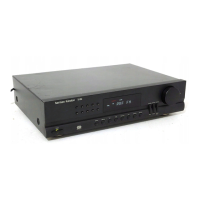
Do you have a question about the Harman Kardon TU950 and is the answer not in the manual?
| Usable FM Sensitivity, Mono | 11.2 dBf |
|---|---|
| 50dB Quieting Sensitivity, Stereo | 40.3 dBf |
| Signal-to-Noise Ratio @ 65dBf, Mono | 80 dB |
| Signal-to-Noise Ratio @ 65dBf, Stereo | 73 dB |
| Capture Ratio | 2.0 dB |
| AM Sensitivity, External Antenna | 400 µV/m |
|---|---|
| AM Image Rejection | 35 dB |
| AM IF Rejection | 50 dB |
| AM Signal-to-Noise | 45 dB |
| Audio Output Voltage @ 400Hz, 80% Mod. | 500 mV |
| IF Rejection | 100 dB |
|---|---|
| Image Rejection | 90 dB |
| Spurious Response Rejection | 70 dB |
| Power Consumption | 110 W |
| Audio Output Voltage @ 1kHz, 40kHz Mod | 500 mV |
| Dimensions (W×H×D) | 440 x 95 x 300 mm |
|---|---|
| Weight | 4.3 kg |
| Depth measurement includes knobs, buttons and antennas | Yes |
Instructions to prevent electric shock by not removing covers and referring servicing to qualified personnel.
Warning to protect the appliance from rain, moisture, fire, or electric shock.
Instructions for proper insertion of the plug into the electrical outlet to prevent shock.
Guidelines for safely handling the power cord, including disconnection and avoiding damage.
Advice on positioning the unit to ensure proper ventilation and avoid environmental hazards.
Warnings against self-servicing the unit and guidance on handling potential issues.
Instructions for safe and effective cleaning methods for the audio equipment.
An overview of the RDS feature and its benefits for enhancing FM radio listening.
Buttons and knobs for unit power, station tuning, and mode selection.
Controls for storing, recalling, and scanning preset stations, including memory and numeric buttons.
Buttons for managing RDS, AF, PTY, FM modes, RF/IF bands, and display settings.
The main digital display showing frequency, station information, and operating status.
Controls unit power on/off with associated indicator lights.
Button to cycle through and display various station and RDS information.
Buttons for storing and recalling stations into memory and preset locations.
Buttons for RDS activation, alternate frequencies (AF), and program type (PTY) selection.
Button to manually enter or modify names for non-RDS stations.
Primary control for tuning stations manually or using automatic tuning methods.
Cycles through FM, MW, and LW frequency bands.
Switches between stereo and mono reception modes for FM broadcasts.
Adjustments to mitigate RF interference and optimize reception from adjacent stations.
Engages automatic tuning (AUTO) or manual tuning modes for station selection.
Buttons for selecting preset stations manually or scanning through them automatically.
Initiates an automatic scan through preset memory stations, playing each briefly.
Adjusts the intensity of the front panel display indicators.
Used to select or enter stations into memory locations.
Main display panel showing frequency, station information, and operating status.
Diagrams and instructions for connecting FM and AM antennas, including adapters.
Connections for audio output to amplifier and for remote control integration.
Connection point for the AC power cord.
Guidance on selecting and connecting indoor or outdoor FM antennas for optimal reception.
Instructions for connecting the AM antenna and positioning it for best reception.
Instructions for connecting the tuner's output to a preamplifier or integrated amplifier.
Connecting the tuner for remote control operation with other Harman Kardon components.
Instructions for connecting the unit to the AC main outlet or a switched outlet.
How to select desired frequency bands (FM, MW, LW).
Steps for automatically scanning and tuning to FM stations with sufficient signal.
Method for tuning LW or MW bands, or FM stations when automatic tuning is not optimal.
Step-by-step guide to storing up to 30 stations into memory.
Methods for directly recalling or scanning through preset memory locations.
Solutions for issues like the display not illuminating or no sound being heard.
Troubleshooting FM sound interference, stereo display issues, and distorted audio.
Resolving problems with buzzing, intermittent signals, preset station entry, and RDS data.
Addressing poor radio reception and locating few stations by checking antenna and connections.
Detailed technical specifications for FM reception sensitivity, selectivity, and audio output.
Technical specifications for AM reception sensitivity, image rejection, and audio output.
Information on power consumption, dimensions, and weight of the unit.
Statement of compliance with technical standards and EEC directive for interference suppression.
